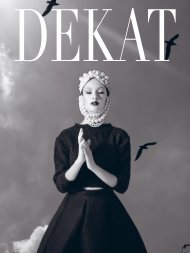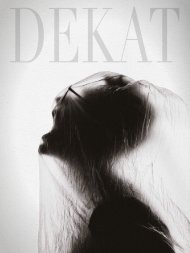1
Create successful ePaper yourself
Turn your PDF publications into a flip-book with our unique Google optimized e-Paper software.
She met a young, dashing teacher and, in 1920, married Willem Johannes Pienaar, oddly not in the village church but in a private house. Helen was 22 and Johannes 27. Pienaar<br />
was flamboyant, outspoken and a man of the theatre. It is said that her father wasn’t taken with him. From the start the marriage wasn’t easy. The couple lived up North for a<br />
while. He stayed in Volksrust, she taught in the Cullinan mining community, but they performed together at times in plays that Pienaar produced. One such was a musical Saul. The<br />
relationship deteriorated, with Helen probably having had an abortion (she never wanted children), and Johannes playing the field with women. They divorced when he sued her for<br />
desertion in 1926. A meagre alimony didn’t counter a large debt Johannes left when he departed overseas.<br />
To say Helen was adrift after this, is also to say little is known of where she found herself. She seems to have worked in Cape Town for a while, but about 1928 she returned to<br />
Nieu-Bethesda. Both parents were ailing and, as the only unmarried sibling, she had to take on their care. In 1941 her beloved mother Hester died of breast cancer, and she had sole<br />
responsibility of her cantankerous father Piet, exiled to the back room now known as The Lion’s Den at the Owl House. He died in 1945.<br />
A very small town community and its communal suspicions and gossip were not a comfortable fit for the woman who had increasingly become self-educated in the worlds of<br />
literature, religion, theatre and art. As her unconventional views took hold, she became more reclusive – adding to the alienation from the locals. Yet Helen had a secret life here too.<br />
A new man moved into the village in 1939. Johannes Hattingh brought along his wife and daughters. He was a tall man and, it is said, was struck by lightning while working on a roof.<br />
Years later another bolt would damage his brain. He and Helen became friends (perhaps something more) and he helped plan and plot when she started her mission to transform<br />
the dreary cottage into the space of light and magic. In 1947 Hattingh and family moved to Peddie, but he often came visiting and stayed. Because he was so tall, Martins extended<br />
his bed in the Green Room. Helen, by the way, didn’t sleep in one room only and moved nightly from one to the other to experience her environment.<br />
Another man came into her life in 1954. The widower Johannes Machiel Niemand was ten years older than she. They got married in Graaff-Reinet. The reason was never clear, for<br />
they went their separate ways immediately and divorced a few years on. Light is the key to understanding Helen Martins’ art mission: in and towards the light. Just think how dark<br />
the Karoo nights then without electricity would be when the gloom in the human condition overpowers. She filled spaces with lamps and candles everywhere, reflecting off mirrors<br />
and walls. First move was to bring light into the house with bigger windows, removing walls, if need be. For this she employed local builder Piet van der Merwe. It was also his<br />
contribution that created the fine forms of the dwellings in the Camel Yard.<br />
When Martins invented the magical medium of sparkling crushed coloured glass (using various methods, including a coffee grinder), another handyman, Jonas Adams helped with<br />
the tricky technique of sticking it on walls. One can image the amazement of these ordinary locals working on things that for many didn’t make sense. The star performer, finally, was<br />
Koos Malgas and Martins called him her 'artist'. He worked for her for twelve years until her death, and probably delved deeper into her creative psyche than anyone. She showed<br />
him what she wanted and he made the prototypes – until she was satisfied and then he installed it. Koos Malgas was the sorcerer’s apprentice in every happy way.<br />
When the call went up to preserve the Owl House in 1980, there was no other way than to call on Malgas, his knowledge and expertise. The house would not look the way it does<br />
now if Malgas did not return to spend his last days in his and Martins’ town of birth. Helen Martins was well into middle age when her journey of transformation began and lasted<br />
some three decades of planned and ad hoc invention. Not a corner of the family home was left untouched in creating ‘her world’.<br />
She got by on a meagre pension and spent most of it on the things needed for her creation: paint, wire, cement, labour. Self-sustenance was of less importance to her. Not worried<br />
about appearance, her increasingly forlorn, tatty look increased the image of scary eccentricity to locals. But the Camel Yard with more than 500 cement statues, structures and<br />
bas reliefs was a natural draw for locals and visitors who had heard about it. She liked the attention, but was often shy of her shoddy appearance. At Christmas all the lamps and<br />
candles would be lit and she opened the door to visitors – her spiritual world of magic shared with whoever wanted to be touched.<br />
Yet as she aged, her psychic gloom manifested also in deteriorating physicality of worn hands, arthritis, damaged feet, lack of proper sustenance and fading eyesight. Loneliness<br />
and depression grew darker and darker. On Sunday, August 8, 1976 she died a horrible death, having swallowed caustic soda.<br />
While her legacy remains in a corner of the Karoo, Fugard’s masterpiece The Road to Mecca took her life and tribulations as an artist to the world.<br />
14 FOR THE LOVE OF LIGHT<br />
FOR THE LOVE OF LIGHT 15





